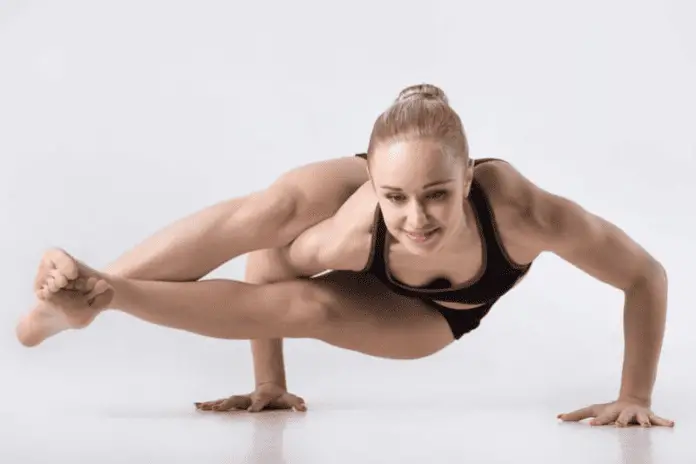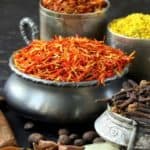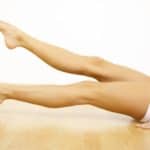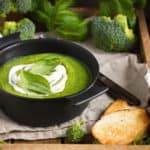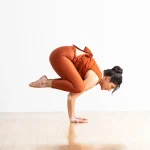Astavakrasana, also known as the Eight-Angle Pose, is a demanding yet rewarding yoga posture that requires a combination of strength, flexibility, balance, and self-assurance.
This challenging pose primarily targets the upper back, making it essential to establish a solid foundation of core and back strength before attempting it. The greater your strength, the less likely you are to place excessive strain on your shoulders, elbows, and wrists when executing the pose. To prepare for Astavakrasana safely, it’s advisable to invest several weeks or even months in practicing poses such as Chaturanga Dandasana, also known as the Four-Limbed Staff Pose. Maintaining proper alignment during these preparatory poses will help you develop the necessary upper back and core strength to confidently support your body’s weight in this advanced yoga pose.
In this challenging strength-building posture, bringing your thighs together is a helpful technique, as suggested by yoga instructor Amy Ippoliti. By pressing your thighs firmly against your upper arm, you can create the necessary lift to transition into the pose smoothly. It’s common for the bottom leg to lag behind, so this action helps maintain balance and stability.
If adjusting your thighs in this way slightly shifts your position, don’t worry; it’s acceptable as long as you make the necessary adjustments with your arms to compensate. Amy advises that it’s acceptable if the weight of your legs causes your shoulders to dip slightly, but it’s crucial to actively move your shoulders backward to prevent them from being overwhelmed by the weight. This balance and adjustment ensure that you can perform the pose safely and effectively.
Sanskrit
Astavakrasana (ahsh-tah-vah-KRAHS-ah-nah)
asta = eight
vakra = bent, curved
Eight-Angle Pose basics
Benefits of the Eight-Angle Pose, known as Astavakrasana, encompass physical and mental enhancements. This challenging yoga posture offers a range of advantages, including:
- Strength Enhancement: Astavakrasana builds strength in your upper back, arms, and core. The pose requires significant muscular engagement to maintain balance and stability.
- Flexibility Improvement: As you work towards achieving Astavakrasana, you’ll notice improved flexibility in the back of your body and the back of your legs. Regular practice helps increase overall flexibility.
- Posture Enhancement: Practicing this pose can lead to better posture as it encourages awareness of your body’s alignment. Improved posture can alleviate issues related to slouching and back pain.
- Increased Body Awareness: Astavakrasana demands a heightened sense of body awareness and control. This mindfulness can extend beyond your yoga practice and improve your overall awareness of body movements in daily life.
- Energy Boost: Engaging in challenging yoga poses like Astavakrasana can invigorate your body and boost energy levels. This can be especially beneficial when you’re feeling fatigued or lethargic.
- Confidence Building: Mastering Astavakrasana can enhance your self-confidence. Achieving a challenging yoga pose can instill a sense of accomplishment and self-assurance in your practice.
Incorporating Eight-Angle Pose into your yoga routine can provide a comprehensive set of physical and mental benefits, promoting strength, flexibility, and self-confidence while enhancing your overall well-being.
Other Eight-Angle Pose perks:
- Strengthens your thighs, core, chest, arms, and back of your wrists (wrist extensors)
- Stretches the palm sides of your wrists (wrist flexors), which counteracts the effects of typing.
- Provides a twist to the lumbar spine.
How to Perform Astavakrasana (Eight-Angle Pose)
Astavakrasana, also known as the Eight-Angle Pose, is an advanced yoga posture that requires strength, flexibility, and balance. This pose offers numerous physical and mental benefits while challenging your body and mind. Here’s a step-by-step guide on how to practice Astavakrasana correctly.
Starting Position: Dandasana (Staff Pose)
- Begin in Dandasana, also known as Staff Pose. Sit with your legs extended straight in front of you.
Entering Astavakrasana:
- Bend your right knee and bring your right thigh out to the right side. Position your right knee over your right shoulder. Press your right leg firmly against your arm to stabilize yourself. If you cannot bring your leg onto your shoulder, hold it with both hands as high as you comfortably can.
- Slightly tilt your body forward and place your hands on the floor, with your palms shoulder-width apart, on either side of your hips. Maintain your grip on your right shoulder with your right calf and inner thigh.
- Engage your abdominal muscles and press your hands into the mat to lift your hips and left leg off the ground.
- Hook your left ankle over your right ankle and press them together. Draw your inner thighs toward your upper arm, then bring your chest forward and bend your elbows while swinging your legs to the right.
- Straighten your legs by pressing through your heels and breathe deeply in this pose.
Exiting Astavakrasana:
To exit the pose, inhale to lift your chest and swing your legs back toward the center of the mat. Exhale, uncross your ankles and return to Dandasana.
Beginner Tips:
- If you find it challenging to balance in Astavakrasana, you can rest your bottom hip and leg on a bolster for added support.
Pose Exploration:
Learning Astavakrasana is a journey that not only enhances physical strength and flexibility but also patience and self-awareness. Embrace the process of trial and error, and observe the effects of your actions without judgment.
- Pay attention to the positioning of your legs. Does your top leg stay securely hooked over your shoulder? How much lift can you achieve with the bottom leg?
- As you work on lifting your legs, focus on drawing your navel toward your spine, which will contribute to building core strength.
Important Considerations:
- Avoid attempting this pose if you have any wrist, elbow, or shoulder injuries.
Teacher Tips:
Here are some cues to guide your students safely through Astavakrasana:
- Emphasize the importance of warming up before attempting this challenging arm balance. Encourage mindful movements in and out of the pose.
- Teach students to use their abdominal muscles, not their arms, to lift their hips. Building core strength through poses like Paripurna Navasana (Boat Pose) and Plank Pose is crucial.
- Incorporate hamstring stretches like Uttanasana (Standing Forward Bend) and Adho Mukha Svanasana (Downward-Facing Dog Pose) into your students’ practice.
- Suggest placing hands about a foot in front of the hips to facilitate elbow bending and hip lifting.
Pose Variations:
- Eight-Angle Pose with Blocks: Use yoga blocks placed under your hands at the lowest height to provide more space for lifting into the pose. Keep your torso upright while learning the pose before gradually leaning forward while maintaining lifted legs.
- Side Crane Pose (Parsva Bakasana): If your hamstrings are tight, Parsva Bakasana is an alternative pose to build arm strength. Draw the elbows toward the body, similar to Chaturanga Dandasana.
Why We Love Astavakrasana:
Astavakrasana is a challenging yet empowering pose. It might seem unattainable at first, but with consistent practice and the right guidance, you can discover your strengths and potential. It’s a reminder that you are often stronger than you think, both physically and mentally.
Preparatory and Counter Poses:
As with any complex yoga pose, preparation and counter poses are essential. These poses prepare the body for Astavakrasana and release tension afterward.
Preparatory Poses:
- Plank Pose
- Chaturanga Dandasana (Four-Limbed Staff Pose)
- Utthita Parsvakonasana (Extended Side Angle)
- Utthan Pristhasana (Lizard Pose)
- Bakasana (Crane Pose) | Kakasana (Crow Pose)
- Parsva Bakasana (Side Crane Pose)
- Paripurna Navasana (Boat Pose)
- Marichyasana III
Counter Poses:
- Dandasana (Staff Pose)
- Matsyasana (Fish Pose)
- Paschimottanasana (Seated Forward Bend)
- Balasana (Child’s Pose)
Anatomy Insights:
Astavakrasana combines elements of a twist and an arm balance, engaging various muscle groups and promoting stability. Here are some key anatomical points to consider:
- The pose stretches the lower-side erector spinae and spinal rotators.
- Hip flexion lengthens the gluteus maximus muscles, hamstrings, and gastrocnemius/soleus complex.
- Flexing the hips involves the psoas, adductors, and pectineus muscles.
- Engaging the oblique abdominals and transverse abdominis helps maintain balance.
- The legs pressing against the arm create a lock or bandha, taking the effort into bones and ligaments rather than muscles.
- Evert the feet (turn them outward) and pull them apart to stabilize the ankles and deepen the twist.
Is Eight-Angle Pose Advanced?
Astavakrasana or Eight-Angle Pose is one of the advanced arm balance poses in yoga. The meaning of ‘asta’ in Sanskrit is eight and ‘vakra’ is curved or bent. It is an excellent way to develop your stability and equilibrium while strengthening your wrists and arms.
What are the disadvantages of the triangle pose?
Following are the Contraindications of Triangle Pose (Trikonasana): Injury and Surgery: Students with neck, knee, shoulder, or ankle injuries should avoid this pose. Athletes and runners who have hamstring or ankle injuries should rest the muscles and not attempt this pose.
Closing Thoughts:
Astavakrasana is a challenging yet rewarding yoga pose that offers numerous physical and mental benefits. With practice, patience, and guidance, you can develop the strength, flexibility, and self-awareness required to master this advanced asana. Remember to prioritize safety and alignment, especially if you have any existing injuries or limitations.
















